Contents
[I - Introduction] [II - An
early attempt ...]
[III - Review of pre-2000 'Thamama' ...] [IV
- Thamama and Kahmah groups]
[V - New holostratigraphic nomenclature ...]
[VI - Conclusion ...]
[bibliographic
references] and ... [Plates]
Département des Sciences de la Terre et de l'Univers, UFR des Sciences et Techniques, Université de Bretagne Occidentale (UBO), 6, avenue Le Gorgeu - CS 93837, F-29238 Brest Cedex 3 (France)
Manuscript online since September 28, 2008
The stratigraphic framework of the uppermost Jurassic - Lower Cretaceous interval of the Gulf area is revised using both historical and recently acquired paleontological (ammonites, calpionellids, foraminifers, 'calcareous' algae), sedimentological and sequential information. The Kahmah regional Series ranging in age from Late Tithonian to Gargasian (= middle Aptian) times is subdivided into regional stages, named from bottom to top: Rayda (with two substages, Bu Haseer and Belbazem), Salil, Zakum, Lekhwair, Kharaib, Hawar, and Shu'aiba. The Kahmah rests either on strata representing the Habshan regional Stage, which is the last term of the Sahtan regional Series (locally absent due to a stratigraphic hiatus in basinal areas), or on much older strata; it is followed either by the Bab regional Stage (locally absent due to a stratigraphic hiatus on platform areas), or by the Sabsab regional Substage (the lowermost part of the Nahr Umr regional Stage), both of which are assigned the Wasi'a regional Series. The Kahmah succession (as well as those of the Sahtan below and the Wasi'a above) is discontinuous, i.e. punctuated by sedimentary hiatuses due to forced regressions, some of significant importance (in the Zakum or in the Bab, and those bounding the Hawar and the Shu'aiba).
Biostratigraphy; holostratigraphy; sequence stratigraphy; Abu Dhabi; Iraq; Oman; Qatar; Saudi Arabia; Sharjah; United Arab Emirates; Jurassic; Cretaceous; Thamama; Kahmah; Sahtan; Wasi'a; Habshan; Rayda; Bu Haseer; Belbazem; Salil; Zakum; Lekhwair; Kharaib; Hawar; Shu'aiba; Sabsab; Nahr Umr; ammonites; calpionellids; dasycladalean algae; foraminifers.
B. (2008).- Holostratigraphy of the Kahmah regional Series in Oman, Qatar, and the United Arab Emirates.- Carnets de Géologie / Notebooks on Geology, Brest, Article 2008/07 (CG2008_A07)
Synthèse stratigraphique intégrée de la Série régionale du Kahmah aux Émirats Arabes Unis, en Oman et au Qatar.- Le canevas stratigraphique du Jurassique sommital et du Crétacé inférieur de la région du golfe arabo-persique est repris sur la base de données publiées il y a un certain temps (données historiques) et d'autres plus récemment acquises, données issues de la paléontologie (ammonites, calpionelles, foraminifères, algues 'calcaires'), la sédimentologie et de l'analyse séquentielle. La Série régionale du Kahmah qui correspond à un intervalle-temps Tithonien terminal à Gargasien (= Aptien moyen) se subdivise en étages régionaux avec de bas en haut : l'Étage de la Rayda (avec deux sous-étages, le Bu Haseer et le Belbazem), le Salil, le Zakum, le Lekhwair, le Kharaib, le Hawar et la Shu'aiba. Cette Série régionale du Kahmah repose soit sur des couches attribuées au Habshan, dernière unité de la Série régionale du Sahtan, soit sur des couches bien plus anciennes ; elle est suivie soit par l'Étage régional du Bab (localement absent en raison d'une lacune stratigraphique en domaine de plate-forme), soit par le Sous-Étage régional du Sabsab (la partie basale de l'Étage régional du Nahr Umr), l'un comme l'autre étant attribués à la Série régionale de la Wasi'a. L'enregistrement sédimentaire du Kahmah (mais également ceux du Sahtan dessous et de la Wasi'a dessus) est discontinu, c'est-à-dire ponctué par des lacunes sédimentaires dues à des régressions forcées, dont certaines d'importance majeure (au sein du Zakum ou du Bab, ou celles qui bornent le Hawar ou la Shu'aiba).
Biostratigraphie ; holostratigraphie ; stratigraphie séquentielle ; Abou Dabi ; Arabie Séoudite ; Émirats Arabes Unis ; Irak ; Oman ; Qatar ; Sharjah ; Jurassique ; Crétacé ; Thamama ; Kahmah ; Sahtan ; Wasi'a ; Habshan ; Rayda ; Bu Haseer ; Belbazem ; Salil ; Zakum ; Lekhwair ; Kharaib ; Hawar ; Shu'aiba ; Sabsab ; Nahr Umr ; algues dasycladales ; ammonites ; calpionelles ; foraminifères.
Some believe that the stratigraphy of the Middle East oil province is a fait accompli. However a look at the stratigraphic charts for the Gulf region published at the end of the twentieth century shows them to be a jigsaw puzzle of units with no coherent schema of correlation. The stratigraphy of the uppermost Jurassic - Lower Cretaceous interval we deal with here is no exception. Part of the problem arises from the misuse of lithostratigraphic criteria for temporal correlation since rock-stratigraphy is basically correlation of facies. Indeed the same name has been given to sets of rocks of similar facies on either side of a national border although they represent discrete chronostratigraphic intervals (see for instance the Habshan Formation). The synthesis attempted here redraws the regional framework integrating all available historical, bio-, litho-, and sequence stratigraphic information in an approach known as holostratigraphy. An anonymous reviewer raised the concern that 'Holostratigraphy should be replaced by Sequence Stratigraphy' but this should not be the case. Indeed the prefix 'holo-', derived from the Greek 'holos' meaning 'whole', suggests that Sequence Stratigraphy is just one approach within the broader holostratigraphic field.
An early version of this procedure applied in the Gulf region was presented at the Abu Dhabi International Petroleum Exhibition and Conference (ADIPEC) in 2000. (2000) demonstrated that many "operational units", i.e. oil-bearing formations in the subsurface defined by petroleum explorationists in the late 1960s and early 1970s, are unconformity-bounded units (UBU). Their limits as defined commonly correspond either to a sequence boundary (SB) or to a transgressive surface (TS), i.e. an unconformity on the shelf that passes basinward into a correlative conformity. Such correlatable subsurface boundaries, usually easily recognizable on well-logs, are traceable over considerable distances from the reference locality, and cores or cuttings provide additional physical evidence regarding the nature of these key bounding surfaces (hard ground, microkarst, erosional surface, etc.).
The basic 'unconformity-bounded unit' (UBU) is called either a synthem or an alloformation (there is a subtle difference in the meanings of these two words, as allostratigraphy deals exclusively with sedimentary rocks): sets of these units are called either a supersynthem or an allogroup and their subdivisions are called subsynthems or allomembers ( et alii, 1987). In the early version of this regional stratigraphic synthesis (, 2000), the author introduced this new nomenclature. However almost ten years after its implementation in the Gulf region the new terminology (synthem, alloformation, etc.) has not been accepted or widely applied. In addition, stratigraphy is a discipline of the Earth Sciences that is still evolving: the International Stratigraphic Guide (, 1976) is not a code, and consequently some flexibility in its quotidian use is permissible. Therefore, rather than attempting to institute this new classification in the Gulf area, it would have been more useful to have called these units regional stages (the unit ranking above them would be a regional series and the one below a regional substage) and to have pointed out that each of them has a type section which should be referred to when an identification of these supra-regional stratigraphic units is attempted elsewhere. By so doing we revert to the original diagnosis of a stage: that is a chronostratigraphic unit defined by the same criteria (lithology, fossil contents, bounding discontinuities) used in the early days of stratigraphy by one of its European fathers, Alcide Dessalines d' (1849-1852) (see the description of 'classical stages' by and , 2008, p. 118).
Most lithostratigraphic units described from Middle Eastern outcrops satisfy the requirements of the International Stratigraphic Guide, and so are formally named. To the contrary most units introduced in the literature for the subsurface successions were named in informal terms for they were first mentioned in proprietary reports and then perpetuated in later reports, either published or unpublished proprietary reports.
Some companies operating in the Middle East oil province (Abu Dhabi, Dubai, Oman, Qatar,
Sharjah) arranged Geological Liaison Meetings to standardize regional stratigraphic nomenclature. They formulated a practical schema for the so-called Thamama Group, of which the Abu Dhabi section was issued by et alii
(1975):
Fig. 1 ![]() . Now, some 30 years later, it is appropriate to review these early attempts at regional stratigraphic standardization.
. Now, some 30 years later, it is appropriate to review these early attempts at regional stratigraphic standardization.
According to et alii (1975), the 'Thamama Group' in Abu Dhabi includes the section from the base of the Nahr Umr Formation down to the upper limit of the Hith Formation, and consists from top to bottom of:
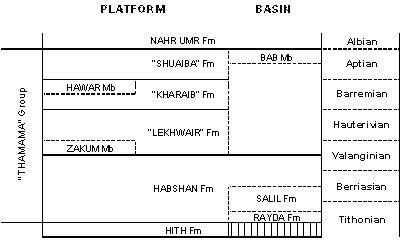
Click on the image to enlarge it.
Figure 1: The extant lithostratigraphic classification in Abu Dhabi and neighboring emirates ( et alii, 1975).
In Saudi Arabia, the Thamama Group is delimited by the Wasi'a Group above and the Hith Anhydrite below. According to (1968), the upper boundary of the Thamama Group falls at discrete stratigraphic levels depending on its location: outcrop or subsurface. In outcrop, the type Thamama comprises, from top to bottom: the Biyadh Sandstone, and the Buwaib, Yamama, and Sulaiy formations. In the subsurface, beds not present in outcrop include the Shu'aiba Formation and the upper part of the Biyadh Formation. (1968) states, "it is quite possible (…) that the type-Biyadh includes beds assigned to the Wasi'a (…) in subsurface sections". This is a typical example of what has been called an 'obscure unconformity' in the various versions of the International Stratigraphic Guide (a "sand-on-sand relationship" as quoted from , 1968); this unconformity should be present in the historical Biyadh type-section; if so, the Wasi'a should be extended significantly downward in time.
In Qatar, according to and (1975), the name 'Thamama Group' includes in descending order the Shu'aiba, Hawar, Kharaib, Ratawi, Yamama, and Sulaiy formations.
In Oman, the Kahmah Group ( et alii, 1974), considered either to be a synonym for or a lateral equivalent of the so-called 'Thamama Group', is subdivided into six formations, from top to bottom: the Shu'aiba, Kharaib, Lekhwair, Habshan, Salil, and Rayda formations.
The following sections present a review of the available information (type, boundaries, lithology, fossil content) on member- or formation- ranked units.
The Rayda Formation is a formal lithostratigraphic unit based on a section exposed in Jebel Akhdar, Oman. First mentioned by F. (1969, unpublished report), it was effectively published by et alii (1975); (1988) and et alii (1990) provided additional information on its type section. This facies-driven unit consists mainly of porcellaneous lime mudstones with nodular cherts and is equivalent to group g and group h of and (1959).
A prominent erosional hiatus exists between Rayda deposits and the underlying Upper Jurassic limestones of the Sahtan Group ( et alii, 1990; et alii, 1990; et alii, 1990; et alii, 1993; et alii, 2005). Locally, distinctive facies are developed at the base of the Rayda immediately above this unconformity, called the pre-Kahmah unconformity. and (1959) introduced for a locality on Jebel Hagab in Ras Al Khaimah the name Ashhab Limestone, also designated as group g, to include "characteristically breccia-conglomerates with associated porcellaneous limestones" with a thickness of 58.5 m. Unfortunately, they misinterpreted these beds as solution breccias; they are subaqueous "channelized debris flow conglomerates" ( et alii, 1990) and, although subordinate limestones contain calpionellids, they erroneously ascribe them a questionable "Late Oxfordian - Tithonian age". In the type area of the Rayda, i.e. at Jebel Akhdar. et alii (1990) reported the local occurrence of a condensed horizon with limestones pebbles. In Wadi Hagil, a locality near and 's area, et alii (1993) also describe "unstratified clast-supported conglomerates" above the pre-Kahmah unconformity; these beds were pictured in et alii (2006, Fig. 2)
Microfossils.- Calpionellids are common in the several facies of the Rayda Formation. and (1959; , 1971) found Calpionella alpina in their group g (Ashhab Limestone) from Jebel Hagab. In addition, et alii (1993) identified various calpionellid assemblages ranging from Zone B to Zone D (C. alpina , C. elliptica , Calpionellopsis simplex (), Tintinnopsella carpathica ( et ), and Remaniella cadischiana ()) from the same facies in neighbouring Wadi Hagil. All of these occurrences are in Ras Al Khaimah. They seem credible although not yet substantiated by figured specimens. Recently, et alii (2005) reported calpionellid occurrences from Wadi Muaydin and Wadi Quri at Jabal Akhdar, Oman; they illustrated two associations, one with Crassicollaria parvula (), Cr. brevis () and Calpionella alpina , the other with Calpionellopsis simplex (), C. oblonga () and Remaniella cadischiana ().
In Amoco wells Sajaa N° 1, 2, and 3 in onshore Sharjah, and (1985) reported the occurrence of calpionellids. In two ADCO wells (L1-A and in Jumaylah N° 1) in onshore Abu Dhabi, de (1994) cited Calpionella alpina and C. elliptica ; he illustrated some calpionellid sections which he refers to C. alpina (op. cit., Pl. 5.6, figs. 6-7).
There is no evidence for calpionellid zones A or E in the Rayda facies, which therefore is mostly Berriasian in age.
Macrofossils.- According to F. (in et alii, 2005), ammonites from the extreme base of the Rayda in wadi Quri are Perisphinctids, not Berriasellids. This finding indicates that deposition of the Rayda began in Late Tithonian times.
Remark.- The Rayda facies cannot be regarded as a lateral equivalent of the Salil facies as erroneously interpreted in et alii (1990, Fig. 11), (1990, Fig. 7), etc.. The time span of the Rayda is Late Tithonian and Berriasian while the Salil has never been dated older than Valanginian.
The Habshan Formation is an informal lithostratigraphic unit first defined in ADCO (ex ADPC) well Bab N° 2, in onshore Abu Dhabi; ADMA well Zakum N° 1 is the reference section for the offshore of Abu Dhabi. The name 'Habshan' was introduced by et alii (1975) as a substitute for the double-barreled name 'Yamama/Sulaiy' which had been used previously in Abu Dhabi.
Microfossils.- Microfossils originally described from the Sulaiy or Yamama formations in Saudi Arabia include Bramkampella arabica , Pseudocyclammina sulaiyana , P. cylindrica , Everticyclammina eccentrica , and E. elegans . In a paper published in Revue de Micropaléontologie (1965), comments on 's "unfortunate attitude of splitting up a taxon merely on account of very slight variations"; for instance he stated that specimens referred to Pseudocyclammina aff. lituus () do not expressly designate that species, but are a much smaller form called Pseudocyclammina sulaiyana , a synonym for "Pseudocyclammina lituus forme a" sensu (1959, 1965).
More recently, and (1991) concluded that:
The recent finding of Campbelliella striata () and Anchispirocyclina lusitanica ()
(Pl. 1, figs. A-B ![]() ) in core samples from field
'X' (offshore Abu Dhabi) indicates a Tithonian age for the lower and middle Habshan there. The dasycladalean alga Campbelliella striata () ranges from Kimmeridgian to Tithonian ( and ,
1994). The foraminifer Anchispirocyclina lusitanica (), which was also reported from the type Sulaiy in Saudi Arabia by et alii
(1966) under the name "Iberina lusitanica ()", is a marker for the Tithonian ( and ,
1979).
Other common algal occurences are dasycladales: Clypeina
sulcata () (in the lowermost part of the section), Otternstella lemmensis ()
(Pl. 1, figs. E-G
) in core samples from field
'X' (offshore Abu Dhabi) indicates a Tithonian age for the lower and middle Habshan there. The dasycladalean alga Campbelliella striata () ranges from Kimmeridgian to Tithonian ( and ,
1994). The foraminifer Anchispirocyclina lusitanica (), which was also reported from the type Sulaiy in Saudi Arabia by et alii
(1966) under the name "Iberina lusitanica ()", is a marker for the Tithonian ( and ,
1979).
Other common algal occurences are dasycladales: Clypeina
sulcata () (in the lowermost part of the section), Otternstella lemmensis ()
(Pl. 1, figs. E-G ![]() ), Salpingoporella anulata ,
and
S. (Hensonella) dinarica
(Pl. 1, fig. C
), Salpingoporella anulata ,
and
S. (Hensonella) dinarica
(Pl. 1, fig. C ![]() ; ,
2002, Pl. I, figs.
6-7).
; ,
2002, Pl. I, figs.
6-7).
Among the Berriasian microfossils recently identified from field 'X' (offshore Abu Dhabi), (2000) mentioned Arenobulamina sp., a form known from the Late Berriasian, and Montsalevia elevata et alii, a form known from Late Berriasian to Early Valanginian times; both were found in the uppermost part of the Habshan.
Remarks.- It is obvious that the base of the Thamama Group (i.e. its contact with the Hith Formation) is not coeval with the base of the Kahmah Group (i.e. the base of the Rayda Formation): it is older. In addition, although it is desirable that lithostratigraphic units should not contain major unconformities, the Habshan Formation does
so, at least in onshore Abu Dhabi, where this unit must be properly redefined. Most unconformities found in the Tithonian portion of the type Habshan (some were illustrated in et alii,
2006, Fig. 4) are probably intercepted by the pre-Kahmah unconformity. It was therefore suggested the type Habshan be split into at least two formations, one with Tithonian microfossils (the lower and medial portions) and the other containing mostly Berriasian microfossils (the upper part).
(2000) recommended restricting the term Habshan to the lower and median parts of the type section. He introduced two new names, Bu Haseer and Belbazem, to designate respectively the lower and upper portions of the upper part of the type section. The new Bu Haseer Formation displays distinctive sedimentary features and an association of fossils, markedly indicative of
a brackish environment (Purbeckian-like) facies (Figs. 2 ![]() ,
3
,
3 ![]() & 4
& 4 ![]() )
with Charophytes
(Pl. 1, fig. D
)
with Charophytes
(Pl. 1, fig. D ![]() ) and
Salpingoporella (Hensonella) dinarica
(Pl. 1, fig. C
) and
Salpingoporella (Hensonella) dinarica
(Pl. 1, fig. C ![]() ).
).
 |
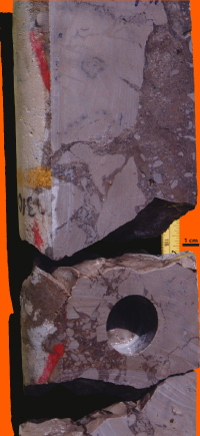
|
[2] |
[3] |
Click on the images to enlarge them.
Figure 2: A set of 2 core slabs illustrating karstic features.- Bu Haseer regional Substage, well N° ZQ of field 'X', offshore Abu Dhabi.
Figure 3: Another set of 2 core slabs illustrating karstic features.- Bu Haseer regional Substage, well N° IBO of field 'X', offshore Abu Dhabi.
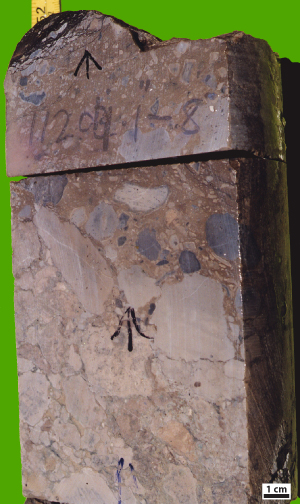
Click on the image to enlarge it.
Figure 4: A set of 2 core slabs illustrating the transition from karstic features to lag deposits (floatstone of extraclasts with a wacke- to pack- stone matrix).- Bu Haseer regional Substage, well N° IFI of field 'X', offshore Abu Dhabi.
The Salil Formation is the 'sister' unit of the Rayda Formation: both were first mentioned by F. (1969, unpublished report) and later effectively published by et alii (1975). Information on the type section of Jebel Akhdar, Oman, can be found in (1988) and et alii (1990). The Salil is predominantly argillaceous limestones and calcareous shales, probably equivalent to the group i of and (1959).
The Zakum Member was first mentioned by et alii
(1975). It is an informal lithostratigraphic unit first recognized in ADMA well Zakum N° 1 in offshore Abu Dhabi
(as "Salil + Zakum" in Figs. 5 ![]() ,
left column, and 6
,
left column, and 6 ![]() ). It should be the equivalent of the lower unit of the so-called
'Lekhwair Formation' in onshore Abu Dhabi. It is bounded by two unconformities; the lower one is the pre-Buwaib unconformity, which recorded the drowning of the eastern Arabian carbonate platforms. The Zakum includes both the so-called "Chrysalidina zone" or "Valvulinella zone", and the section immediately below it to the level of the pre-Buwaib unconformity. According to
(1968), this zone "near the middle of the Buwaib Formation" provides highly reliable correlations over most of Saudi Arabia and neighbouring countries; it is identified by the presence
of either one of two fossil markers,
Paravalvulina arabica (), or Pseudocyclammina lituus ()
(Pl.
2, figs. A-C
). It should be the equivalent of the lower unit of the so-called
'Lekhwair Formation' in onshore Abu Dhabi. It is bounded by two unconformities; the lower one is the pre-Buwaib unconformity, which recorded the drowning of the eastern Arabian carbonate platforms. The Zakum includes both the so-called "Chrysalidina zone" or "Valvulinella zone", and the section immediately below it to the level of the pre-Buwaib unconformity. According to
(1968), this zone "near the middle of the Buwaib Formation" provides highly reliable correlations over most of Saudi Arabia and neighbouring countries; it is identified by the presence
of either one of two fossil markers,
Paravalvulina arabica (), or Pseudocyclammina lituus ()
(Pl.
2, figs. A-C ![]() ). and
(1959, p. 89) report this association from their group k in the Musandam Peninsula. This unit consists of a set of three couples that are composed of a more argillaceous interval (commonly with pyritohedra) followed by a more calcareous, microfossil-rich interval.
). and
(1959, p. 89) report this association from their group k in the Musandam Peninsula. This unit consists of a set of three couples that are composed of a more argillaceous interval (commonly with pyritohedra) followed by a more calcareous, microfossil-rich interval.
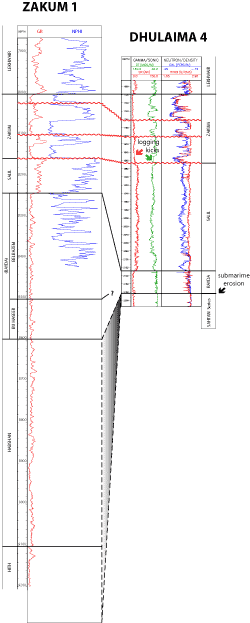 |
 |
[5] |
[6] |
Click on the images to enlarge them.
Figure 5: Correlation of platform (ADMA well Zakum N° 1, modified from et alii, 1975) and basin (PDO well Dhulaima N° 4, modified after et alii, 1997).
Figure 6: Stratigraphic subdivision of the Gamma-Ray log (retrieved from et alii, 1975) for the lower part of the Kahmah section in the well ADMA Zakum N° 1 selected as the reference section for offshore Abu Dhabi.
Microfossils.- A fauna low in diversity characterizes 'environmentally' the argillaceous intervals. Their predominant microfossils are two foraminifers,
Everticyclammina contorta and E. hensoni Pl. 1, fig. H ![]() ), which were originally described from an interval
(Buwaib Formation) supposedly a time-equivalent of the Salil. Their types were found respectively in the Saudi Aramco Abqaiq and Dammam wells.
), which were originally described from an interval
(Buwaib Formation) supposedly a time-equivalent of the Salil. Their types were found respectively in the Saudi Aramco Abqaiq and Dammam wells.
In contrast, the calcareous intervals (a diagnostic feature of the Zakum) yield rich assemblages of both foraminifers and calcareous algae.
(1948a, Pl. XV, figs. 6-7, and Pl. XVII, figs. 1-2) described
Dukhania arabica from QGPC (ex QPC) well Dukhan N° 2 in Qatar where the type level is located in "limestones and shales with Pseudocyclammina lituus". Topotypes were illustrated by et alii
(1975, Pl. II, figs. 1-2) under the name
Pseudochrysalidina (?) arabica (). This foraminifer was also described as
Chrysalidina, Valvulinella, Broeckinella, Paravalvulina or "Valvulines spéciales". It is supposedly unknown from deposits older than the Valanginian (? Late Berriasian). But the large foraminifer Pseudocyclammina lituus (), which
(1968, p. 56) called "Cyclammina sp."
and which he found in the type Buwaib in Saudi Arabia, is not known in the Western
Tethys from deposits younger than the Valanginian (,
1987). As mentioned above, smaller specimens in the Sulaiy and Yamama formations may not be
referable to that species (, 1965). True Pseudocyclammina lituus from the Middle East have been illustrated only rarely.
(1959, Pl. 4, fig. 9) and
(1948b, Pl. IX, fig.
3, and Pl. XIII, fig. 7) figured some from QGPC (ex QPC) Dukhan wells in Qatar. T.C. and R.
(1985) figured specimens from Amoco well Sajaa N° 2 (op. cit.,
Fig. 9.H) and 3 (op. cit., Fig.
9.A) in onshore Sharjah; unfortunately, they ascribed them erroneously to the Habshan Formation, rather than
to the Zakum Member where this species is commonly associated with the fairly common
high-spired Trocholina sp. (also known formerly as Coscinoconus, Pl.
2, fig. E(T) ![]() ).
).
Among other microfossils, (2000) mentioned another foraminifer recently identified from field
'X' (offshore Abu Dhabi),
Montsalevia ? salevensis ( et alii)
(Pl.
2, fig. D ![]() ); this form is known only from the Valanginian.
); this form is known only from the Valanginian.
Finally, regarding the algal
assemblage which commonly includes Actinoporella gr. podolica ()
(Pl. 3, fig. B ![]() ),
Deloffrella quercifoliipora
et , and Terquemella sp., it is noteworthy that the types of both Cylindroporella cruciformis
et
(Pl. 3, figs. A & C-D
),
Deloffrella quercifoliipora
et , and Terquemella sp., it is noteworthy that the types of both Cylindroporella cruciformis
et
(Pl. 3, figs. A & C-D ![]() ) and Holosporella arabica et
(Pl.
2, fig. E(H)
) and Holosporella arabica et
(Pl.
2, fig. E(H) ![]() ) were collected from this interval in offshore Abu Dhabi (TOTAL well Abu Al Bu Khoosk N° 41). Cylindroporella cruciformis was selected as the type of a recently created genus:
Fourcadella 2002 (op. cit., Pl. I, figs. 4-5). It is also known from the so-called
'Yamama' of southern Iraq.
) were collected from this interval in offshore Abu Dhabi (TOTAL well Abu Al Bu Khoosk N° 41). Cylindroporella cruciformis was selected as the type of a recently created genus:
Fourcadella 2002 (op. cit., Pl. I, figs. 4-5). It is also known from the so-called
'Yamama' of southern Iraq.
Remarks.- Using estimates of their respective clay content
(2007, Fig. 3) demonstrated that the abrupt change from the Rayda facies
(porcellaneous lime mudstone with calpionellids) below to the Salil facies (argillaceous limestones and calcareous shales) above
(Fig. 7 ![]() ) marks the Belbazem - Zakum boundary
(Belbazem - Salil boundary in this paper), i.e. the onshore pre-Buwaib unconformity
(Fig. 5
) marks the Belbazem - Zakum boundary
(Belbazem - Salil boundary in this paper), i.e. the onshore pre-Buwaib unconformity
(Fig. 5 ![]() ).
).

Click on the image to enlarge it.
Figure 7: Rayda-Salil boundary at wadi El Assyi, near Nakhl (Oman).
In Oman ( et alii, 1975; , 1988; et alii, 1990) and in Sharjah ( and , 1985), the Salil Formation is overlain by a more calcareous interval that most authors erroneously ascribe to the 'Habshan Formation'. However its assemblage of fossils (for example the occurrence of Pseudocyclammina lituus) strongly suggests that these calcareous levels are both facies and time equivalents of the calcareous levels of the Zakum Member. As demonstrated in (2007, Fig. 3), the age of the type Zakum in offshore Abu Dhabi is equivalent to that of both outcrop units in Oman: the type Salil below and the so-called 'Habshan' above.
Within the type Zakum, the change upward from the lowermost argillaceous sequence (a quiet, deep-water environment) to the first calcareous interval (a shallower and higher-energy environment) is abrupt. It records a rapid lowering of sea level that is a forced regression and registers a change in the
alongshore drift currents that had draped the Berriasian carbonate platforms with argillaceous
materials. It is therefore a major sequence boundary. This abrupt change is like that of the succession in
Oman where an equivalent break marks the top of the type Salil and its transition upward to the so-called
'Habshan'. In recognition of this newly identified boundary it is proposed that the lower limit of the type Zakum be set at this lowermost break
(Fig. 5 ![]() ). It is noteworthy that two similar breaks exist in the remainder of the type Zakum interval and they
too may indicate forced regressions. As this set of triple breaks took place in Valanginian time, the associated forced regressions could be related in some way to the Valanginian glaciations. Such speculation is beyond the scope of the present study; it is a hypothesis that we shall investigate.
). It is noteworthy that two similar breaks exist in the remainder of the type Zakum interval and they
too may indicate forced regressions. As this set of triple breaks took place in Valanginian time, the associated forced regressions could be related in some way to the Valanginian glaciations. Such speculation is beyond the scope of the present study; it is a hypothesis that we shall investigate.
The Lekhwair Formation is an informal lithostratigraphic unit based on a Petroleum Development Oman
(PDO) well in the Lekhwair field of onshore Oman. According to et alii
(1975) the well in question may be N° 6 or more probably is well N° 7
(Fig. 8 ![]() ) as M.
(1988; et alii,
1997)
state. First mentioned by F. (1969, unpublished report), it was effectively published by M.
(1988). The Lekhwair is probably equivalent to groups
'l' and 'm' in and
(1959).
) as M.
(1988; et alii,
1997)
state. First mentioned by F. (1969, unpublished report), it was effectively published by M.
(1988). The Lekhwair is probably equivalent to groups
'l' and 'm' in and
(1959).
In Abu Dhabi, the so-called 'Lekhwair Formation' includes both the Zakum Member and a time-equivalent of the type-Lekhwair (sometimes referred to as the Nasr Formation in unpublished industrial reports).
Microfossils.- (1948b, Pl. XIII, figs. 9, 11 & 15-17) described Cyclammina greigi, later designated as Everticyclammina, from QGPC (ex QPC) well Dukhan N° 2 in Qatar. The type level is "just above the horizon of Pseudocyclammina lituus", i.e. it is probably Valanginian.
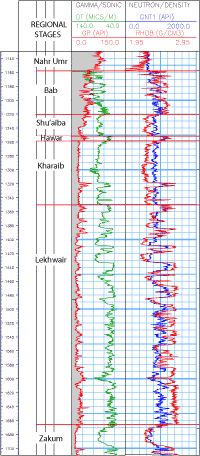
Click on the image to enlarge it.
Figure 8: Kahmah section in Lekhwair well N° 7, onshore Oman (modified from , 1988, and et alii, 1997).
The Kharaib and Hawar formations are informal lithostratigraphic units based on QGPC (ex QPC) well Kharaib N° 1, in onshore Qatar. First mentioned by (1953, unpublished report), they were effectively published by and (1975). They are probably equivalent to group n (with Dictyoconus arabicus, now referred to as Montseciella arabica) and group o of and (1959).
Macrofossils.- From the scree of their group o, and (1959) collected large fossils among which were echinids, including "Heteraster musandamensis " and "H. aff. couloni ". Genuine H. couloni are characteristic of the Hauterivian-Barremian exclusively. On the other hand, according to B. (personal communication), the figures and description given by (1928, p. 642-643, Pl. XLIV, figs. 4.a-b) suggest a synonymy with H. oblongus , a marker for the Bedoulian (= Early Aptian). In et alii (1959), the same species from the Sarmord Formation in northern Iraq is identified as "Heteraster oblongus var. musandamensis ".
Microfossils.- Montseciella arabica was originally described by (1948b, Pl. I, figs. 6-8 & Pl. XIV, figs. 1-12) under the name "Dictyoconus arabicus sp. nov." from QGPC (ex QPC) well Dukhan N° 3 in Qatar, possibly from the lower part of the Kharaib Formation.
A variety of "Orbitolina discoidea ", O. discoidea var. delicata was described by (1948b, Pl. II, figs. 13-14) from the same level in well Dukhan N° 2; it has proven to be a junior synonym of Palorbitolina lenticularis () (, 1963; , 1981). Most early proprietary reports refer to obsolete names, such as "Orbitolina cf. discoidea " which might cover several taxa among which are Valserina sp., Eopalorbitolina transiens ( et , 1999) and Palorbitolina lenticularis ().
Other fossils originally described from the Kharaib Formation include algae, e.g. the dasycladalean alga Cylindroporella sugdeni , 1957, originally described from the Kharaib Formation of the Fahud field in onshore Oman.
Remarks.- An accurate biostratigraphic scale based on Orbitolinids and calibrated on ammonites (see et alii in et alii,
2000) makes possible the inference that the top of the Lekhwair is not younger than Early Barremian, the Kharaib is Barremian to Bedoulian (= Early Aptian) in age, and the Hawar is of Bedoulian (= Early Aptian) age. In the ADMA field
'A', offshore Abu Dhabi ( et alii, 2003), the Kharaib was found capable of subdividision into 4 third-order transgressive-regressive cycles
(Figs. 9 ![]() and
10
and
10 ![]() ):
):
The Hawar cycle could be their cycle Bd 2.
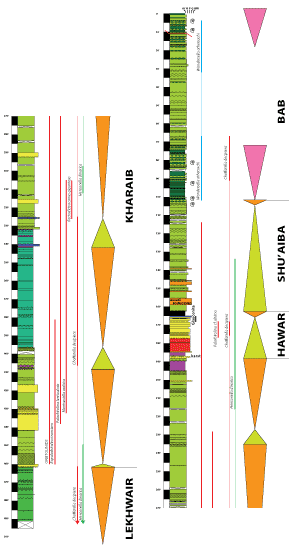
Click on the image to enlarge it.
Figure 9: Stratigraphic subdivision of the upper part of the Kahmah section in the reference well of field 'A', offshore Abu Dhabi (orbitolinid ranges after et alii (2007), thickness in feet, LST pink, TST green, HST orange, M mudstone, W wackestone, P packstone, G grainstone, BFR boundstone-floatstone-rudstone).
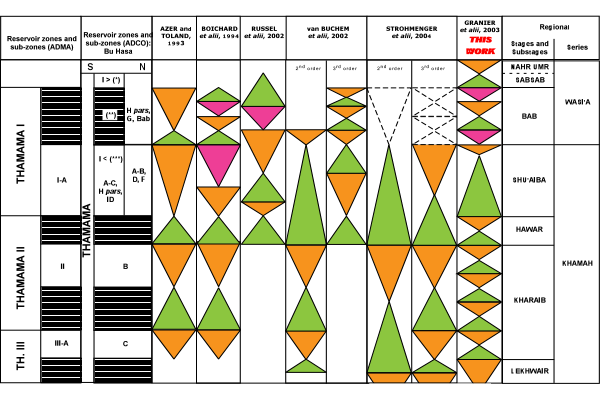
Click on the image to enlarge it.
Figure 10: The relationships of the subdivisions defined by sequence stratigraphy to the main reservoir zones of the upper part of the so-called 'Thamama' in field 'A', offshore Abu Dhabi, according to the several groups of authors (modified from et alii, 2003). *: the Orbitolinid-rich layer and above; **: missing section in the southern part of Bu Hasa field;***: below the Orbitolinid-rich layer.
The fact that the Hawar Formation has been lumped either with the overlying Shu'aiba Formation (in Oman and Iraq) or with the underlying so-called
'Kharaib Formation' (in Abu Dhabi) or with the so-called 'Ratawi Formation' (in Qatar) is due to a misunderstanding of its genesis: it is a discrete unit on its own. In the ADMA field
'A' (see et alii, 2003), the base of the Hawar Formation is made
up of transgressive beach deposits (with keystone vugs
(Pl. 3, fig. E ![]() ), etc.) which cut into the upper levels of underlying shallow-water carbonates. In some locations relics of a pre-existing karstic surface are preserved; therefore this boundary records a lowering of sea-level. The remainder of the unit consists predominantly of offshore carbonate-sand deposits with abundant Palorbitolina lenticularis. The stage of maximum flooding is presumably at the base of the uppermost shale interval that rests on a layer of glauconitic carbonate-sand
(Pl. 3, fig. F
), etc.) which cut into the upper levels of underlying shallow-water carbonates. In some locations relics of a pre-existing karstic surface are preserved; therefore this boundary records a lowering of sea-level. The remainder of the unit consists predominantly of offshore carbonate-sand deposits with abundant Palorbitolina lenticularis. The stage of maximum flooding is presumably at the base of the uppermost shale interval that rests on a layer of glauconitic carbonate-sand
(Pl. 3, fig. F ![]() ). The upper limit of the Hawar Formation is coincident with an abrupt change in sedimentation from the uppermost shale (characteristic of open-marine environments and deposited below storm-wave base) to very shallow-water carbonates (with a rich photophylic algal association characteristic of shallow protected environments). As does the lower boundary, the upper one records a forced regression: the fall
in sea level can be estimated
to have been 40 meters or more. To date most authors ( and ,
1993; et alii,
1994; et alii,
2001; et alii,
2002; van et alii,
2002; et alii,
2004, 2006; etc.)
have overlooked the fossil assemblages (though one should always remember that "fossils
never lie!") and missed this major sequence boundary. The Hawar is a self-standing entity, i.e. a discrete unit bounded by unconformities.
). The upper limit of the Hawar Formation is coincident with an abrupt change in sedimentation from the uppermost shale (characteristic of open-marine environments and deposited below storm-wave base) to very shallow-water carbonates (with a rich photophylic algal association characteristic of shallow protected environments). As does the lower boundary, the upper one records a forced regression: the fall
in sea level can be estimated
to have been 40 meters or more. To date most authors ( and ,
1993; et alii,
1994; et alii,
2001; et alii,
2002; van et alii,
2002; et alii,
2004, 2006; etc.)
have overlooked the fossil assemblages (though one should always remember that "fossils
never lie!") and missed this major sequence boundary. The Hawar is a self-standing entity, i.e. a discrete unit bounded by unconformities.
The Shu'aiba Formation is an informal lithostratigraphic unit based on INOC (ex BPC) well Zubair N° 3, in southern Iraq. First mentioned by P.M.V. (1951, unpublished report), it was effectively published by R.M.S. and S.N. (1958); it was subsequently amended first by H.V. et alii (1959), then by K.M. (1967).
According to R.M.S. and S.N. (1958), the Shu'aiba type-section lies between drilled depths 9,870 ft / 3,008.4 m and 10,132 ft / 3,088.2 m, and "is made up of dolomitic limestones which are coarsely crystalline, porous, and cavernous, with recrystallized Rudistae and with rare Orbitolina discoidea and Choffatella decipiens" (op. cit., p. 1276). The original description by P.M.V. (1951, unpublished report) was significantly different; from top to bottom:
The fauna of this limestone formation is on the whole rather poor with the exception of a rich zone Orbitolina discoidea at the base."
The above succession, in well Zubair N° 3, southern Iraq, is quite similar to that found in most wells of offshore Abu Dhabi. This original description of the type Shu'aiba resembles closely that of an interval from the top of the Bab Member to the base of the Hawar Formation in offshore Abu
Dhabi
(Fig. 11 ![]() ).
).
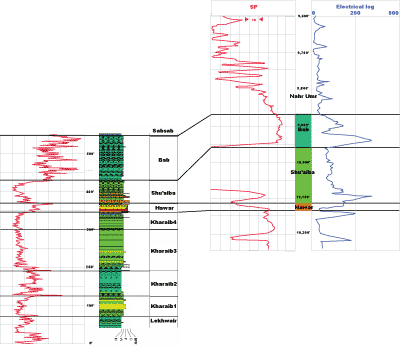
Click on the image to enlarge it.
Figure 11: Correlation of the upper part of the Kahmah section in the reference well of field 'A', offshore Abu Dhabi (from et alii, 2003) with the type section of the Shu'aiba (from et alii, 2003; modified from , 1951, and , 1967) in INOC (ex BPC) well Zubair N° 3 in southern Iraq.
H.V. et alii (1959) reverted to the original description of P.M.V. (1951, unpublished report) while K.M. (1967) significantly revised the top of the unit by lowering it 92 ft / 28.1 m. According to him, the top is at a drilled depth of 9,962 ft / 3,036.4 m, so the level with planktonic foraminifers, 'globigerinids', is excluded. Therefore, in this latest version the type-Shu'aiba includes the Hawar Formation, but excludes its Bab Member.
Macrofossils.- Only one ammonite was found in the Shu'aiba Formation in the ADMA well Umm Shaif N°
2, offshore Abu Dhabi. It was identified as an ancyloceratid by C.W. (1959, unpublished report; and ,
1964; et alii,
1975; and ,
1993). In Umm Shaif N° 3 M. (1992, unpublished report; and ,
1993) found
Diadochoceras sp. and cf. Pseudohaploceras sp.. These three finds strongly imply the
Epicheloniceras martini Zone of Gargasian (= middle Aptian) age. New ammonite findings
(Fig. 12 ![]() ) in fields
'A' and 'B', offshore Abu Dhabi, support a Gargasian age ( and , nearing completion).
) in fields
'A' and 'B', offshore Abu Dhabi, support a Gargasian age ( and , nearing completion).
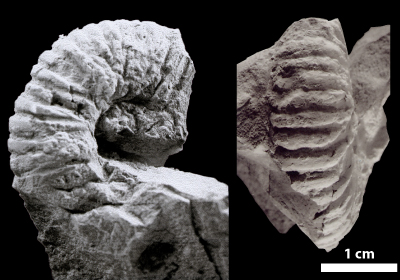
Click on the image to enlarge it.
Figure 12: Colombiceras sp., an ammonite with a strong subquadratic section.- N° FSL 105444, Gargasian (= middle Aptian sensu gallico = lower Upper Aptian sensu anglico), upper Shu'aiba regional Stage, field 'B' (offshore Abu Dhabi).- Photos R. .
Microfossils.- Palorbitolina lenticularis (), found in both the Kharaib and the Hawar, is also reported from the Shu'aiba. Some specimens are illustrated in and (1995, Pl. 10.1, figs. 1-4). These authors illustrated 2 specimens of Praeorbitolina cormyi ( and , 1995, Pl. 10.1, figs. 5-6) from strata higher in the section. According to et alii, 1998, their Pl. 10.1, fig. 5 was erroneously identified as "Orbitolina (Mesorbitolina) lotzei".
In field 'A', offshore Abu Dhabi, facies characteristic of protected shallow-water environments are found at the base of the Shua'iba Formation ( et alii,
2003); they are rich in
'calcareous algae', such as Salpingoporella (Hensonella) dinarica ,
Clypeina ummshaifensis
(Pl. 3, fig. B ![]() ; ,
2002, Pl. I, fig. 2),
Gyroporella lukicae et ,
Cylindroporella lyrata et ,
Gakhumella huberi , etc. and in foraminifers, among them
Voloshinoides murgensis et ,
1993. Then come the deeper-water
Epistominids (Pl. 4, fig. B
; ,
2002, Pl. I, fig. 2),
Gyroporella lukicae et ,
Cylindroporella lyrata et ,
Gakhumella huberi , etc. and in foraminifers, among them
Voloshinoides murgensis et ,
1993. Then come the deeper-water
Epistominids (Pl. 4, fig. B ![]() )
and Choffatella decipiens, which
confirm the overall deepening-upward trend for the remainder of
the section.
)
and Choffatella decipiens, which
confirm the overall deepening-upward trend for the remainder of
the section.
First mentioned by et alii (1975), the Bab Member, which is taken to represent the upper unit of the so-called 'Shu'aiba Formation' in Abu Dhabi, is an informal lithostratigraphic unit first recognized in ADCO (ex ADPC) well Bab N° 2, in onshore Abu Dhabi.
Macrofossils.- Ammonites identified in ADMA well Umm Shaif N° 2 from this interval by C.W. (1959, unpublished report; and , 1964; et alii, 1975; and , 1993) include Cheloniceras (Epicheloniceras) sp. and Colombiceras cf. caucasicum. et alii (1975) also reported Pseudosaynella fimbriata, Pseudohaploceras sp., Diadochoceras sp., Gargasiceras sp., and Dufrenoyia sp., possibly from Bab N° 2, but there are uncertainties with respect to their formational attribution (are they from the Shu'aiba or the Bab?). Except for the presence of a representative of the genus Dufrenoyia that is contrary to this assignment of age these occurrences substantiate a reference to the Epicheloniceras martini Zone of Gargasian (= middle Aptian) age. In addition, new ammonite findings in fields 'A' and 'B' ( and , nearing completion) strongly support a Gargasian age.
Microfossils.- The planktonic foraminifer, Wondersella athersuchi (Pl. 4, fig. B ![]() ), from the lower part of the Bab Member, was first described by and
(1987, Pls. 1-4) in
ZADCO/ADMA well Zakum N° 1 in Abu Dhabi. It was also reported from the same stratigraphic interval in ADMA well Umm Shaif N° 3, Abu Dhabi.
), from the lower part of the Bab Member, was first described by and
(1987, Pls. 1-4) in
ZADCO/ADMA well Zakum N° 1 in Abu Dhabi. It was also reported from the same stratigraphic interval in ADMA well Umm Shaif N° 3, Abu Dhabi.
Nannofossils.- Representatives of
Nannoconus
are abundant but the remains of other nannofossils (coccoliths)
are comparatively rare
(Fig. 13 ![]() ).
).
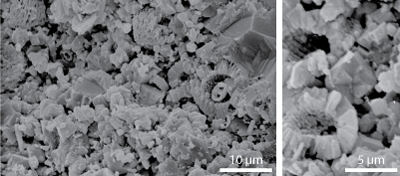
Click on the image to enlarge it.
Figure 13: Highly porous but poorly permeable matrix of the Bab chalks.- Bab regional Stage, field 'A' (offshore Abu Dhabi).
The Sabsab Formation
(see Fig. 14 ![]() ,
for instance) is an informal lithostratigraphic unit based on QGPC (ex
QPC) well Dukhan N° 27, in northwestern Qatar. It was published by and
(1975). Described as "an
oolitic, pellety limestone containing abundant abraded Orbitolinidae", it was erroneously "believed to infill a channel".
,
for instance) is an informal lithostratigraphic unit based on QGPC (ex
QPC) well Dukhan N° 27, in northwestern Qatar. It was published by and
(1975). Described as "an
oolitic, pellety limestone containing abundant abraded Orbitolinidae", it was erroneously "believed to infill a channel".
Microfossils.- Beds with numerous Orbitolinids reported from 'basinal
Shu'aiba' or 'Bab' intervals should most probably be assigned the Sabsab. They lack Palorbitolina lenticularis but contain other species: Orbitolina
(Mesorbitolina) lotzei (Pl. 4, fig. C ![]() ), Orbitolina
(Mesorbitolina) parva (Pl. 4,
figs. D-F & H
), Orbitolina
(Mesorbitolina) parva (Pl. 4,
figs. D-F & H ![]() ; and ,
1995, Pl. 10.1, figs. 8 and 10) and Orbitolina
(Mesorbitolina) texana ( and ,
1995, Pl. 10.1, figs. 7 and 9).
; and ,
1995, Pl. 10.1, figs. 8 and 10) and Orbitolina
(Mesorbitolina) texana ( and ,
1995, Pl. 10.1, figs. 7 and 9).
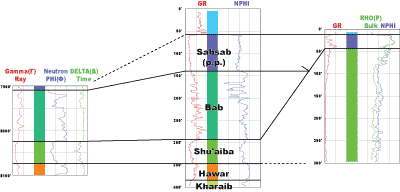
Click on the image to enlarge it.
Figure 14: Correlation of :
The Nahr Umr Formation is an informal lithostratigraphic unit based on INOC (ex BPC) well Nahr Umr N° 2, in southern Iraq. First mentioned by D. (1948, unpublished report), it was effectively published by R.M.S. and S.N. (1958). As now defined it is the lowermost unit of the Wasi'a Group.
There are 2 units of higher rank, i.e. units with a group status, the Thamama and the Kahmah. Both name discrete but time-associated portions of the uppermost Jurassic - Lower Cretaceous interval.
In Saudi Arabia, the finding of presumed Early Cretaceous fossils in the upper part of the Riyadh Formation, above the Hith Anhydrite, led M. (1940, unpublished report) to set these supposed Lower Cretaceous beds apart and place them in a new formation, the Thamama. In an abstract of their talk, M. and R.A. (1952) raised this unit to group status and included in it the Buwaib ("limestone, with shale"), Yamama ("fragmental limestone"), and Sulaiy ("limestone") rock-units, which they elevated to formational rank. R.A. et alii (1956) while mapping the southern Tuwayq quadrangle used this classification. Two years later, while mapping the northern Tuwayq quadrangle, R.A. and L.F. (1958) expanded the group to include the overlying Biyadh Sandstone. Finally, the Shu'aiba Formation, first described from a subsurface section in southern Iraq but also known from subsurface sections in Saudi Arabia, was lumped into the group by R.M.S. and S.N. (1958) for it lies below the so-called 'pre-Wasi'a' unconformity. In a footnote, ( and , 1958) advised that "The significance of this group is that it comprises the marine section between an unconformity, present at outcrop (Dakl al Hith) at the top of the Jurassic Hith Anhydrite, and the next recognised unconformity at the top of Aptian limestone". This is the present view of this controversial group, which is per se an unconformity-bounded unit.
The Kahmah Group is a formal lithostratigraphic unit based on sections exposed on Jebel Akhdar, in Oman ( et alii, 1974). By definition, it is a synonym of the "Upper Musandam Limestone" of and (1959). This group is bounded by two major unconformities, one at the bottom of the Nahr Umr Formation, the other at the top of the Sahtan Group. Therefore it also is an unconformity-bounded unit.
Their respective boundaries eliminate these groups from consideration as possible synonyms or lateral equivalents:
Some would prefer to revert to the original understanding of the Thamama: that is a group comprising only the Buwaib, Yamama, and Sulaiy formations. On the other hand, its abandonment may end the general confusion regarding its upper limit.
Remarks.- Depending on their cultural backgrounds ("from which nationalistic patriotism is not excluded", see et alii, 2008), stratigraphers may use either a two- or a three- fold division of the Aptian Stage: Table 1. This is rather puzzling for the non-specialist especially regarding the question of whether the first letter of upper or late should be capitalized or not!
| APTIAN sensu anglico | APTIAN sensu gallico | ||
| Upper / Late Aptian | uppermost / latest Aptian | upper / late Aptian | Clansayesian |
| middle Aptian | Gargasian | ||
|
Lower / Early Aptian |
Lower / Early Aptian | Bedoulian | |
Table 1: Divisions of the Aptian Stage.
The preceding review of operational units in Abu Dhabi makes clear the feasibility of a classification by unconformity-bounded units (UBU) that I call regional stages. Though changes are necessary in the classification and status of units, there is no real need to introduce new names for the rank or boundary of a unit that has been changed or revised in only a few instances.
It is recommended that henceforth the use of these old names be restricted to the identification of stratigraphic units, with no direct lithologic connotation involved. For instance, the facies of the Shu'aiba at its type locality is not a rudist limestone and the Bab successions containing rudists are not Shu'aiba time-equivalents.
As defined here the Kahmah regional Series comprises from bottom to top (Fig. 15 ![]() ):
):

Click on the image to enlarge it.
Figure 15: The new stratigraphic classification for Abu Dhabi and neighboring emirates. The so-called 'Thamama' includes the succession from the base of the Nahr Umr down to the top of the Hith, that is, it includes the Kahmah regional Series and parts of the Sahtan and Wasi'a regional series (modified from , 2000).
Click on the images to enlarge them.
Figure 16: A set of 3 core slabs illustrating karstic features at the Bu Haseer - Belbazem boundary, well N° IFI of field 'X', offshore Abu Dhabi. The facies above the bedding-parallel stylolithic joint consists of lithoclastic rud- to float- stones with a packstone matrix.
Figure 17: A set of 4 core slabs illustrating the Habshan - Bu Haseer boundary, well N° IFI of field 'X', offshore Abu Dhabi. Slab A: vermicular mudstone of the Habshan; slabs B and C: lag deposit, which forms the extreme base of the Bu Haseer unit, with characteristic pebbles and cobbles; slab D: fossiliferous wackestone.
The revised Habshan, Tithonian in age, constitutes the lower and middle portions of the former Habshan. It is excluded from the Kahmah regional Series as it was laid down before the pre-Kahmah unconformity developed. The lower boundary of the revised Habshan is unchanged in both ADMA well Zakum N° 1 and in the former type section (Bab N° 2). However, its upper boundary is significantly lowered in ADMA well Zakum N° 1. In its former type section that boundary is not yet properly delimited.
The Bab regional Stage, Gargasian (= middle Aptian) in age, is also excluded from the Kahmah regional Series as it was laid down after a major forced regression. Its lower and upper boundaries are unchanged in the type section (Bab N° 2). The lower boundary is conformable in basinal areas, but is correlative with the so-called 'pre-Wasi'a' unconformity on the surrounding platforms.
The next unit, the Sabsab regional Substage, is also part of the Wasi'a regional Series. It represents a transgressive interval which followed the second Bab forced regression. It consists of Orbitolinid-rich beds which accumulated mainly offbank at the toe of the Bab escarpments above the organic-rich Bab facies (as in ADMA well N° 4 of field 'B', offshore Abu Dhabi: et alii, 2003, Fig. 6); locally these beds form a thin veneer capping the karstified surface of the Shu'aiba platforms.
Remarks.- Many paleogeographic maps (see for instance et alii,
2001,
Fig. 5.2) refer to one or two intrashelf
'Bab' basins (these Bab basins are 'perched' on the margins of the continental shelf
that bordered the southern Tethys
Ocean). However the occurrence of the Sabsab in the Dukhan wells of western Qatar (the type
locality) suggests that there was another such basin there too, that is on the western side of the Qatar Arch (a counterpart of the well-known basin in Abu Dhabi on the eastern side of the Qatar Arch). In addition, the record of the Bab in
Zubair, southern Iraq (the type locality of the Shu'aiba), provides more evidence for the existence of such a
pattern in that area too. This pattern and the occurrence of isolated Bab platforms within these basins as documented in et alii
(2003) are probably
partly related to the diapirism of infracambrian salts (Fig. 18 ![]() ).
).

Click on the image to enlarge it.
Figure 18 : Regional basin history, phase three. This figure illustrates the geometrical relationships between the Hawar sequence, the Shu'aiba sequence, the first Bab sequence, the second Bab LST, and the Sabsab TST. Figure caption: A- Bacinella microbial facies; B- rudistid facies; C- lateral facies change; black facies = organic-rich Bab facies; blue facies = Orbitolinid-rich Sabsab facies (modified from , 2000).
Because their logs have been published (Table 2), the reference wells for Abu Dhabi are:
| Regional Stages and Substages |
ADMA Zakum N° 1 BRT (Bottom Rotary Table) |
ADCO Bab N° 2 BRT (Bottom Rotary Table) |
ADMA Umm Shaif N° 88 SS (Sub-Sea) |
||
| (Tops) | (Bottoms) | ||||
| Bab | Sabsab | 6,943' A/ 2,116.3 m | 7,907' / 2,401.1 m | 5,557' C / 1,693.8 m | |
| Shu'aiba | Bab | 7,045' / 2,147.4 m | 8,024' / 2,445.8 m | 5,647' C / 1,721.2 m | |
| Hawar | Shu'aiba | 7,091' / 2,161.3 m | 8,077' / 2,461.9 m | 5,700' C / 1,737.4 m | |
| Kharaib | Hawar | 7,119' A/ 2,169.9 m | 8,098' / 2,468.9 m | 5,722' C / 1,744.1 m | |
| Lekhwair | Kharaib | 7,394' / 2,253.7 m | 8,407' / 2,562.5 m | 5,973' C / 1,820.6 m | |
| Zakum | Lekhwair | 8,002' B/ 2,439.0 m | 9,238' / 2,815.8 m | ||
| Salil | Zakum | 8,158' B/ 2,486.5 m | 9,430' / 2,874.3 m | ||
| Belbazem | Salil | 8,241' B/ 2,511.9 m | 9,525' B / 2,903.3 m | ||
| Bu Haseer | Belbazem | 8,500' / 2,590.8 m | ? ~9,700' / 2,955 m | ||
| Habshan | Bu Haseer | 8,598' / 2,620.7 m | ? ~9,800' / 2,985 m | ||
| Hith | Habshan | 9,103' B/ 2,774.6 m | 10,555' B / 3,217.2 m | ||
Table 2: The new holostratigraphic classification of the Abu Dhabi reference wells. The numerical data in this table are either taken from published depths (A from & , 1968; B from et alii, 1975; C from & , 1993) or derived from correlations between published well logs. ADMA well Zakum N° 1 selected as the reference section for offshore Abu Dhabi by et alii (1975) is my reference for the lower part of so-called 'Thamama Group' for many logs of this well have been published (Sonic log from 6,900' to 9,250' in & , 1968; Neutron log from 7,950' to 8,250' and Gamma Ray log from 7,950' to 91,50' in et alii, 1975). ADCO well Bab (ex Murban) N° 2 is my reference for a central part of my classification. As for my last reference log I chose ADMA well Umm Shaif N° 88 for its main logs have been published (Gamma Ray, Neutron, and Density logs from 5,500' to 6,000' in and , 1993).
As partly summarized in Fig. 10 ![]() , the stratigraphic framework presented herein may differ significantly from alternative schemes (see for instance the interpretation of the Hawar in and ,
1993; et alii,
1994; et alii,
2001; etc.). But from it we can set up a new basinal history
that during Kahmah times involves three discrete phases (Fig. 15
, the stratigraphic framework presented herein may differ significantly from alternative schemes (see for instance the interpretation of the Hawar in and ,
1993; et alii,
1994; et alii,
2001; etc.). But from it we can set up a new basinal history
that during Kahmah times involves three discrete phases (Fig. 15 ![]() ):
):
Phase one began in Late Tithonian times with a major tectonic event that caused block faulting on portions of the Arabian
platform ( et alii, 2006) and with the
"sudden retreat of the continental slope, by about 250 km, accompanied by
intensive erosion" ( et alii, 1990,
p. 58; see also et alii, 2006, Fig. 1). Mega-breccias
('Ashhab Limestone'; see et alii, 2006, Fig. 2) were deposited at the toe of the tilted blocks while pelagic sediments with calpionellids infilled
'neptunian dykes', i.e. the fractures related to the block-faulting. Throughout this period brackish sedimentation with Charophytes (Bu
Haseer) took place on the platform. Later, until the end of the Berriasian, shallow-marine sedimentation
(Belbazem) prevailed there while a carbonate ooze that is now a cherty porcellanite
(Rayda) was deposited in the deeper areas (Fig. 19 ![]() ).
).
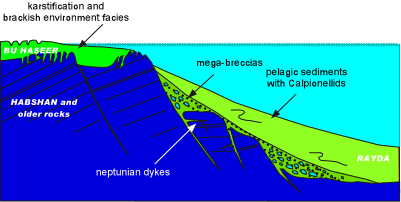
Click on the image to enlarge it.
Figure 19: Regional basin history, phase one, in Belbazem (Berriasian) times. This figure illustrates the main geological features which characterise phase one (karsts, mega-breccias, neptunian dykes). Bu Haseer deposits including some mega-breccias above the pre-Kahmah unconformity (modified from , 2000).
Phase two opened with the general flooding of the platforms, a worldwide event at the beginning of Valanginian times. It is manifested by the predominantly argillaceous Salil
sedimentation which forms thick wedges
off the edges of platforms. A set
('triplet') of forced regressions led to the deposition of the shallow-water calcareous Zakum levels, that may have occurred in Late (?) Valanginian times
(Fig. 5 ![]() ). Except for these short events, most of the early stages of this phase display an overall deepening upward trend. Deposition of shallow-water carbonates did not return until near the end of Lekhwair times. Following that shoaling, the Kharaib interval
(Barremian-Bedoulian) recorded a series of low amplitude oscillations in relative sea-levels (deepening and
shallowing).
). Except for these short events, most of the early stages of this phase display an overall deepening upward trend. Deposition of shallow-water carbonates did not return until near the end of Lekhwair times. Following that shoaling, the Kharaib interval
(Barremian-Bedoulian) recorded a series of low amplitude oscillations in relative sea-levels (deepening and
shallowing).
Phase three includes part of the Aptian (Bedoulian and Gargasian, excluding the
Clansayesian). It starts with a forced regression (shown by a significant downward shift of facies and
culminating in local karstic features) followed by the subsequent Hawar transgression over an inherited Kharaib ramp setting. Following the Hawar which is delimited by 2 forced regressions,
the Shu'aiba strata represent a time favoring the growth of rudistid reefs and the development of
intrashelf-basins between these structures. Another forced regression in this distinctive geomorphological setting ended the depositional history of the Kahmah
(Fig. 18 ![]() ).
).
The Wasi'a regional Series starts in the deeper areas of the intra-shelf basins with the chalks
(Nannoconid oozes) of the lower Bab while rudist reefs continued growing in shallower areas (on the flanks of the Shu'aiba reefal escarpments and above halokinetic domes in intrashelf basins). During that time large parts of the former Shu'aiba platform were
exposed and suffered karstification. There were 2 of these lowstand episodes, one at the beginning of the Bab regional Stage and one at the end of it. During these episodes organic-rich sedimentation took place in the starved intrashelf basins inherited from Shu'aiba times. The subsequent Nahr Umr regional
Stage began with a transgressive episode, the Sabsab regional Substage. It marks the return to a predominantly argillaceous sedimentation that resulted from the flooding of the exposed Bab and Shu'aiba platforms
(Fig. 9 ![]() ).
).
I wish to thank Abu Dhabi Marine Areas - Operation Company, the Abu Dhabi National Oil Company, and their management for permission to publish a first version of this paper at the 9th ADIPEC (2000). To honour the confidentiality of some technical information, this new version uses only published (or anonymized) data. This work is dedicated to two former colleagues in ADMA, Adel and Hagop , both deceased.
Special thanks go to Nestor (one of the pioneers of the middle-eastern geology) for his help in polishing my English text, and to my colleagues A.S. , S.K. , R. , R. , J. , B. , R. , B. , P. , J.E. de , G.S. , R. , R. , H.T. , M.D. , and C. for having provided me over the past decade with relevant literature and new palaeontological information.
Editorial note: Vicissitudes of this manuscriptIn January 2007, a journal editor-in-chief invited me to publish a revision of proposals on a subject previously presented at the 9th ADIPEC in his journal. I was very pleased to have an opportunity to present my ideas to a larger audience. However due to disagreement regarding the status of 1) the so-called 'Habshan' in Oman, 2) the lower boundary of the Kahmah in platform settings, 3) the lower boundary of the Wasi'a in basinal settings, and 4) the existence of clinoforms in the Habshan-Zakum time interval, I decided to withdraw my draft from this journal and to publish it in Carnets de Géologie. The comments that follow are presented apart from the main text of this article as they represent specific responses to these points of disagreement and their integration into the main text would have lessened its readability and the logic of its presentation. 1) The so-called 'Habshan' in Oman is neither a facies- nor a time- equivalent to the type-Habshan of Abu Dhabi, a sequence that very few people have studied. In its original version ( et alii, 1975) the type-Habshan of Abu Dhabi was considered to be of Tithonian and Berriasian age. In its amended version (, 2000) it is restricted to the Tithonian alone, although the so-called 'Habshan' in Oman is Valanginian (that is, it is a time equivalent of the Zakum). 2) The oldest biostratigraphic records (ammonites) concerning the base of the Rayda, immediately above the bounding unconformity, are of latest Tithonian age. The new Habshan, which is identified only in platform areas, covers a span of time equivalent to most of the Tithonian Stage; its lower boundary (with the underlying Hith) is by far older than the base of the Rayda. 3) The lower boundary of the Wasi'a in platform areas corresponds to the boundary between the Nahr Umr (above) and the Shu'aiba (below). When the unconformity is tracked basinward from the shelf, it is found to be below the Bab wedges and to mark the boundary between the overlying Bab and a basinal Shu'aiba. 4) The last point concerns the presumed identification by some geophysicists of clinoforms with Habshan facies in their shallower / upper part, Rayda facies in their deeper / lower part, and Salil facies in the transitional interval. Such an hypothesis obviously conflicts with the geological facts (biostratigraphy, etc.) documented in the body of this article. Surprisingly, but perhaps not unexpectedly, the same geophysicists did not recognize the block faulting that affects Upper Jurassic (including the new Habshan) and older strata. The so-called clinoforms are a combination of Sahtan fault-blocks and Salil clinoforms. After having passed the filtering of the journal reviewers, the revised manuscript was - without my knowledge - forwarded to and circulated among a broader panel of referees, a group of professionals employed by service, independent or national companies operating in the Middle East. It was then that the four "scientific" (quotation marks intentional) disagreements were evinced. The credibility of the model I am defending should not be besmirched by what may appear to be a conflict of interest. Over the years oil companies have formulated several schemas intended to collate the relationships of oil-bearing strata of the Middle East. These tables are but a hodge-podge of disparate data and do not reflect the true sequence of events and stratigraphic relationships developed in part from the indisputable fossil evidence that I present here. Only scientific integrity motivates me for I have no "economic" reason to advance "my" model in contravention of others. But some companies or their representatives sell a "technical" expertise. Should they acknowledge errors in their geological models their credibility would be put in question. Nevertheless, I would welcome the opportunity to discuss the stratigraphic framework presented herein with any interested party. Bruno Brest, July 10, 2008 |
K.M. (1967).- Geology of the Arabian peninsula - Southwestern Iraq.- Geological Survey Professional Paper, Washington, 560-G, 54 p.
S.R. & C. (1993).- Sea level changes in the Aptian and Barremian (Upper Thamama) of offshore Abu Dhabi, UAE.- 8th Middle East Oil Show and Conference, Proceedings, Al Manamah, vol. 2, SPE 25610, p. 141-154.
F.T. & A.R.E. (1987).– On Wondersella athersuchi, a new stratigraphically significant hedbergellid foraminiferan from the Cretaceous Shuaiba Formation in the Middle East.- Journal of Micropalaeontology, London, vol. 6, part 1, p. 39-48.
F.T. & J.E. (1991).– 's "new lituolid foraminifera" from the Mesozoic of Saudi Arabia.- Micropaleontology, New York, vol. 37, Nº 1, p. 41-59.
F.T. & G. (1964).- Lower Cretaceous-Upper Jurassic stratigraphy of Umm Shaif field, Abu Dhabi Marine Areas, Trucial Coast, Arabia.- American Association of Petroleum Geologists, Bulletin, Tulsa, vol. 48, N° 2, p. 191-206.
J.-P. & É. (1979).- Essai de synthèse de répartition de foraminifères benthiques du Jurassique supérieur.- Compte Rendu sommaire des Séances de la Société géologique de France, Paris, fasc. 2, p. 69-71.
R.A., A.S. & H. (1994).- Cycle boundary types and related porosity evolutions: examples of the Upper Thamama Group in Field "A" (Offshore Abu Dhabi, UAE).- 6th Abu Dhabi International Petroleum Exhibition and Conference, Abu Dhabi, ADSPE # 76, p. 417-428.- GEO'94, The Middle East Petroleum Geosciences, vol. I, p. 191-201.
R.A. & L.F. (1958).- Geologic map of the northern Tuwayq quadrangle, Kingdom of Saudi Arabia.- Miscellaneous Geologic Investigations, United States Geological Survey, Washington, Map I-207 A.
R.A., R.D., G.F. & R.O. (1956).- Geologic map of the southern Tuwayq quadrangle, Kingdom of Saudi Arabia.- Miscellaneous Geologic Investigations, United States Geological Survey, Washington, Map I-212 A.
F.S.P. van, B., H., J., A.I., I.M., H.H.J., W.H. & M. van (2002).- High-resolution sequence stratigraphic architecture of Barremian/Aptian carbonate systems in northern Oman and the United Arab Emirates (Kharaib and Shu'aiba formations).- GeoArabia, Al Manamah, vol. 7, Nº 3, p. 461-500.
C.W., R.M., J.C. & S.R. (1992).- Integrated reservoir study and modeling of the Shuaiba reservoir, Bu Hasa field, Abu Dhabi, United Arab Emirates.- 5th Abu Dhabi Petroleum Conference, Abu Dhabi, SPE 24509, ADSPE 1001, p. 299-312.
A., R. & M. (1998).- Early Aptian - Barremian orbitolinid Foraminifera from the Qishn Formation of Al Mukalla (Hadramawt, Southern Yemen). Comparisons with adjacent regions.- Zeitschrift für geologische Wissenschaften, Berlin, Band 26, Heft 5/6, p. 543-561.
A. & R. (1999).- Late Barremian orbitolinid Foraminifera from northern Somalia.- Bollettino della Societá Paleontologica Italiana, Modena, vol. 38, N° 1, p. 3-13.
T.C. & R.W. (1985).- Carbonate sediment-fill of an oceanic shelf, Lower Cretaceous, Arabian Peninsula. In: P.D. & P.M. (eds.), Deep-water carbonates: buildups, turbidites, debris flows and chalk - a core workshop.- Society of Economic Paleontologists and Mineralogists Core Workshop, Nº 6, p. 266-302.
H.V., R. & D.M. (1959).- Iraq, Mesozoic and Palaeozoic.- Lexique stratigraphique international - Asie, Paris, vol. III, fasc. 10 a, 333 p.
H.S. (1971).- Calpionellid stratigraphy and the Jurassic-Cretaceous boundary in South-East Iran. In: Colloque du Jurassique, Luxembourg, 1967.- Mémoire du BRGM, Orléans, N° 75, p. 213-247.
G.F. (1957).- New calcareous algae from the Arabian Peninsula.- Micropaleontology, New York, vol. 3, N° 3, p. 227-230.
N., X., O., L.G. & P.Y. (2006).- Lower Cretaceous Stage durations combining radiometric data and orbital chronology: Towards a more stable relative time scale?- Earth and Planetary Science Letters, Amsterdam, vol. 246, n° 3-4, p. 407-417.
A.F. & R.C.C. (1968).- The geology and reservoir characteristics of the Zakum oil field, Abu Dhabi.- Proceedings of the Second AIME Regional Technical Symposium, Dhahran, p. 39-61.
K.W., M.G.A., M.W., M., W.F.H. & B.M. (1974).- Geology of the Oman Mountains.- Verhandelingen van het Koninklijk Nederlands geologisch minjbouwkundig Genootschap (Transactions of the Royal Dutch Geological and Mining Society), Deel 31, part one (text): 423 p., part two (tables and illustrations), part three (enclosures).
B. (1987).- Le Crétacé inférieur de la Costa Blanca entre Busot et Altea, Alicante (Espagne) : biostratigraphie, sédimentologie, évolution tectono-sédimentaire.- Mémoires des Sciences de la Terre, Université Pierre et Marie Curie, Paris, 87-49, part I (text): 281 p., part II (plates).
B. (2000).- Lower Cretaceous stratigraphy of Abu Dhabi and the United Arab Emirates - A reappraisal.- The 9th Abu Dhabi International Petroleum Exhibition & Conference, October 15th-18th, Conference Proceedings, Abu Dhabi, ADIPEC 0918, p. 526-535.
B. (2002).- Algues dasycladales, nouvelles ou peu connues, du Jurassique supérieur et du Crétacé inférieur du Moyen-Orient. In: I.I. & S. (eds.), Research advances in calcareous algae and microbial carbonates.- Proceedings of the 4th IFAA Regional Meeting, Cluj-Napoca, August 29 - September 5, 2001, p. 103-113.
B. (2007).- On the track of a major trans-Tethyan discontinuity. In: L.G., S. & D. (eds.), Relations between the northern and southern margins of the Tethys ocean during the Cretaceous period.- Carnets de Géologie - Notebooks on Geology, Brest, Memoir 2007/02, Abstract 07 (CG2007_M02/07), p. 32-37.
B., A.S., R., S.K. & R. (2003).- New insight on the stratigraphy of the "Upper Thamama" in offshore Abu Dhabi (U.A.E.).- Carnets de Géologie - Notebooks on Geology, Maintenon, Article 2003/05 (CG2003_A05), 17 p.
B. & R. (1991).- Cylindroporella cruciformis et Holosporella arabica, deux Dasycladacées nouvelles du Groupe Thamama, (? Portlandien-) Berriasien- Aptien d'Abu Dhabi, Emirats Arabes Unis.- Cretaceous Research, London, 12, p. 403-410.
B. & R. (1994).- Inventaire des Algues Dasycladales fossiles. II° partie - Les Algues Dasycladales du Jurassique et du Crétacé.- Revue de Paléobiologie, Genève, vol. 12, N° 1 (1993), p. 19-65.
B., M., P., G. & W. (2008).- The Aptian Stage : Input from the historical stratotype.- Abstract, CD-ROM, 33rd International Geological Congress, 6-14 August 2008, Oslo, HPS-10 Stratigraphic subdivisions of the Cretaceous System: State of the art (abstract).
B., R.G. & N.J. (2006).- Discussion on the Jurassic evolution of the Arabian carbonate platform edge in the central Oman Mountains, Geological Society of London Journal, Vol. 162, 2005, pp. 349-362.- Journal of the Geological Society, London, Vol. 163, N° 6, November 2006, p. 1047-1050. URL: http://jgs.lyellcollection.org/cgi/content/full/163/6/1047
I. (1981).- Variation range, evolution, and biostratigraphy of Palorbitolina lenticularis () (Foraminiferida, Lituolacea) in the Lower Cretaceous of the Dinaric Mountains in Yugoslavia.- Paläontologische Zeitschrift, Stuttgart, Band 55, Heft 3-4, p. 191-204.
A.E., S.G., M.W. & J.E. (1990).- The Lower Kahmah Group of Oman: the carbonate fill of a marginal shelf basin. In: A.H.F., M.P. & A.C. (eds.), The geology and tectonics of the Oman region.- Geological Society Special Publication, London, Nº 49, p. 109-125.
T.H., G.C. & B.N. (1975).- The stratigraphy and sedimentation of the Thamama Group (Lower Cretaceous) of Abu Dhabi.- Ninth Arab Petroleum Congress, Dubai, 107(B-3), 11 p.
H.D. (1976).- International stratigraphic guide. A guide to stratigraphic classification, terminology and procedure.- John Wiley & Sons, New York, 233 p.
F.R.S. (1948a).- XLI.- Foraminifera of the genus Trocholina in the Middle East.- The Annals and Magazine of natural History, London, 11th series, vol. xiv (1947), Nº 115, p. 445-459.
F.R.S. (1948b).- Larger imperforate Foraminifera of south-western Asia. Families Lituolidae, Orbitolinidae and Meandropsinidae.- British Museum (Natural History), London, 127 p.
R.G.S. & M. (1959).- The Musandam Limestone (Jurassic to Lower Cretaceous) of Oman, Arabia. In: C. et alii (eds.), Contributions à la géologie de la péninsule arabique.- Notes et Mémoires sur le Moyen-Orient, Paris, tome VII, p. 69-93.
M.W. (1988).- Stratigraphic and rock unit nomenclature in the oil-producing area of interior Oman.- Journal of Petroleum Geology, Beaconsfield, vol. 11, Nº 1, p. 5-60.
G.M. (1928).– The geology and tectonics of Oman and of parts of south-eastern Arabia.- Quarterly Journal of the Geological Society, London, vol. LXXXIV, part 4, p. 585-670.
E. & J.-P. (1993).- Specie nuove di Foraminiferi bentonici dell'Aptiano inferiore delle Murge (Italia Meridionale).- Rivista Italiana Italiana di Paleontologia e Stratigrafia, Milano, vol. 99, N° 2, p. 213-224.
J.E. de (1994).- 5. Upper Jurassic - Lower Cretaceous stratigraphy: the Arab, Hith and Rayda Formations in Abu Dhabi. In: M.D. (ed.), Micropalaeontology and hydrocarbon exploration in the Middle East.- British Micropalaeontological Society Publication Series, Chapman and Hall, Cambridge, p. 81-111.
W. (1959).- Biocaractères et analyse morphométrique des espèces jurassiques du genre Pseudocyclammina (Foraminifères). Pseudocyclammina lituus ().- Revue de Micropaléontologie, Paris, vol. 2, Nº 3, p. 153-172.
W. (1965).– Some comments on C.D. 's new Lituolid Foraminifera from Saudi Arabia.- Revue de Micropaléontologie, Paris, vol. 8, Nº 1, p. 37-40.
W. (1966).– Final remarks on C.D. 's new Lituolid Foraminifera from Saudi Arabia.- Revue de Micropaléontologie, Paris, vol. 9, Nº 1, p. 56.
A.R., J.A. & E. (1997).- Catalogue of Oman lithostratigraphy.- CD-ROM, Petroleum Development Oman, Muscat, 373 p.
G.S. (1994).- Geological time scale (1994).- Comptes Rendus de l'Académie des Sciences, Paris, t. 318, (série II), n° 1, p. 59-71.
A.D. d' (1849-1852).- Cours élémentaire de paléontologie et de géologie stratigraphiques.- Victor Masson, Paris, 3 vols.
R.M.S. & S.N. (1958).- Stratigraphy of the Kuwait-Basra area. In: L.G. (ed.), Habitat of oil.- The American Association of Petroleum Geologists, Tulsa, p. 1252-1278.
R.-W., L.F., C.D. & E.L. (1966).- Geology of the Arabian Peninsula. Sedimentary Geology of Saudi Arabia.- Geological Survey Professional Paper, Washington, 560-D, 147 p.
R.-W. (1968).- Saudi Arabia (excluding Arabian Shield).- Lexique stratigraphique international - Asie, Paris, vol. III, fasc. 10 b 1, 177 p.
B.R. & J.D. (1990).- Jurassic and Early Cretaceous platform margin configuration and evolution, central Oman Mountains. In: A.H.F., M.P. & A.C. (eds.), The geology and tectonics of the Oman region.- Geological Society Special Publication, London, Nº 49, p. 69-88.
D., J., F., M., M. & C. (1990).- Sedimentary aspects of the Eo-Alpine cycle on the northeast edge of the Arabian Platform (Oman Mountains). In: A.H.F., M.P. & A.C. (eds.), The geology and tectonics of the Oman region.- Geological Society Special Publication, London, Nº 49, p. 49-68.
C.D. (1964).- Lituolid foraminifera from the Jurassic and Cretaceous of Saudi Arabia.- Micropaleontology, New York, vol. 10, Nº 4, p. 405-414.
C.D. (1965).- A reply to Wolf 's "Some comments on C.D. 's new Lituolid Foraminifera from Saudi Arabia".- Revue de Micropaléontologie, Paris, vol. 8, Nº 3, p. 185-188.
J. & S., eds. (2008).- Stratigraphy terminology and practice.- Editions TECHNIP, Paris, 163 p.
M., G., J.-P., F. & F. (2005).- Jurassic evolution of the Arabian carbonate platform edge in the central Oman Mountains.- Journal of the Geological Society, London, Vol. 162, N° 2, p. 349-362. URL: http://jgs.lyellcollection.org/cgi/content/full/162/2/349
S.D., M., B. & G.M. (2002).- Rock types and permeability prediction from dipmeter and image logs: Shuaiba reservoir (Aptian) Abu Dhabi.- American Association of Petroleum Geologists, Bulletin, Tulsa, vol. 86, Nº 10, p. 1709-1732.
A. (Chairman) & International Subcommission on Stratigraphic Classification (1987).- Unconformity-bounded stratigraphic units.- Geological Society of America, Bulletin, Boulder, vol. 98, p. 232-237.
R. (1963).– Palorbitolina, ein neus Subgenus der Gattung Orbitolina (Foram.).- Neues Jahrbuch für Geologie und Paläontologie, Abhandlungen, Stuttgart, Band 117, p. 346-359.
R., F.S.P. van, A., B., A. & B. (2007).- Orbitolinid biostratigraphic zonation of Barremian-Aptian carbonate platforms of the southern Arabian plate. In: Regional depositional history, stratigraphy and palaeogeography of the Shu'aiba, 1st Arabian plate geology workshop abstracts, 12-15 January 2008, Muscat (Oman).- GeoArabia, Al Manamah, vol. 12, N° 4, p. 148-149.
R., B., M.A., L., R., J. & A. (2000).- Corrélations biostratigraphiques entre la coupe d'Organyà (Pyrénées catalanes, NE de l'Espagne) et le Sud-Est de la France pour l'intervalle Valanginien-Aptien.- Treballs del Museu de Geologia de Barcelona, N° 9, p. 5-41.
R., S. & J.M. (1975).- Parurgonina calinensis , & 1968 dans le Malm du Djebel Téioualt (Constantinois, Algérie).- Eclogae geologicae Helvetiae, Basel, vol. 68, N° 2, p. 319-326.
R.W. (1990).- Chronostratigraphy of the Cretaceous carbonate shelf, southeastern Arabia. In: A.H.F., M.P. & A.C. (eds.), The geology and tectonics of the Oman region.- Geological Society Special Publication, London, Nº 49, p. 89-108.
P.R., R., D.M., R.B., S.H., A.P., A.D. & M.D. (2001).- Arabian plate sequence stratigraphy.- GeoArabia, Special Publication, Al Manamah, 2, 371 p.
M. & R.A. (1952).- 3. Mesozoic rocks of Eastern Saudi Arabia. In: Association Round Table.- The American Association of Petroleum Geologists, Bulletin, Tulsa, vol. 36, Nº 5, p. 909.
C.J., L.J., A., M., K., O., A. & O. (2004).- High-resolution sequence stratigraphy of the Kharaib Formation (Lower Cretaceous, UAE).- 11th Abu Dhabi International Petroleum Exhibition and Conference, Abu Dhabi, SPE 88729, 10 p.
C.J., A., O., A., T., L.J., K., L., S.A. & J.C. (2006).- High-resolution sequence stratigraphy and reservoir characterization of Upper Thamama (Lower Cretaceous) reservoirs of a giant Abu Dhabi oil field, United Arab Emirates. In: P.M. & L.J. (eds.), Giant hydrocarbon reservoirs of the world: From rocks to reservoir characterization and modeling.- American Asssociation of Petroleum Geologists, Memoir, Tulsa, Nº 88, Society of Economic Paleontologists and Mineralogists, Special Publication, Tulsa, p. 139-171.
W. & A.J. (1975).- Qatar peninsula.- Lexique stratigraphique international - Asie, Paris, vol. III, fasc. 10 b 3, p. 7-88.
C., R.G. & G.M. (1993).- Upper Jurassic and basal Cretaceous outcrop sequence stratigraphy of Wadi Hagil, Ras Al Khaimah.- 8th Middle East Oil Show & Conference, Proceedings, Al Manamah, 1, SPE 25581, p. 533-543.
W. & H. (1995).- 10. Orbitolinid Biostratigraphy of the Shuaiba Formation (Aptian), Oman - implications for reservoir development. In: M.D. (ed.), Micropaleontology and hydrocarbon exploration in the Middle East.- Chapman and Hall, Cambridge, p. 221-241.
(for the purpose of confidentiality, field and well names as well as sample depths are not given)
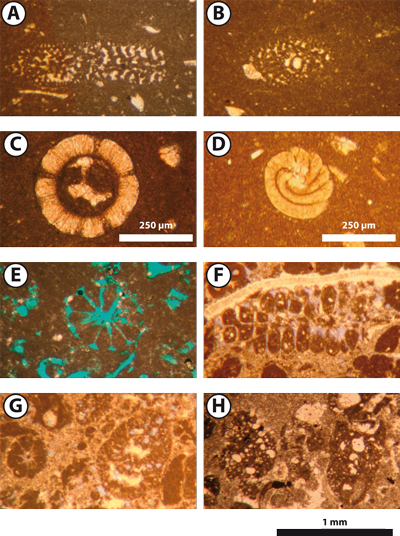
Click on the image to enlarge it.
Plate 1: fig. A. Photomicrograph 01-22: Anchispirocyclina lusitanica ().- Bu Haseer regional Substage, field 'X' (offshore Abu Dhabi); fig. B. Photomicrograph 01-23: Anchispirocyclina lusitanica ().- Bu Haseer regional Substage, field 'X' (offshore Abu Dhabi); fig. C. Photomicrograph 01-18 (scale bar = 250 µm): Salpingoporella (Hensonella) dinarica .- Bu Haseer regional Substage, field 'X' (offshore Abu Dhabi); fig. D. Photomicrograph 01-20 (scale bar = 250 µm): gyrogonite of Charophyte.- Belbazem regional Substage, field 'X' (offshore Abu Dhabi); fig. E. Photomicrograph 01-19: Otternstella lemmensis ().- Belbazem regional Substage, field 'X' (offshore Abu Dhabi); fig. F. Photomicrograph 01-29: Oblique to sub-axial section of Otternstella lemmensis () (o).- Belbazem regional Substage, field 'X' (offshore Abu Dhabi); fig. G. Photomicrograph 01-30: Various sections of Lituolids and a transverse section of Otternstella lemmensis () (to the left).- Belbazem regional Substage, field 'X' (offshore Abu Dhabi); fig. H. Photomicrograph 01-28: Everticyclammina sp..- Salil regional Stage, field 'X' (offshore Abu Dhabi).

Click on the image to enlarge it.
Plate 2: fig. A. Photomicrograph 01-24: Axial section of Pseudocyclammina lituus ().- Zakum regional Stage, field 'X' (offshore Abu Dhabi); fig. B. Photomicrograph 01-25: Sub-axial section of Pseudocyclammina lituus ().- Zakum regional Stage, field 'X' (offshore Abu Dhabi); fig. C. Photomicrograph 01-26: Sub-equatorial section of Pseudocyclammina lituus ().- Zakum regional Stage, field 'X' (offshore Abu Dhabi); fig. D. Photomicrograph 01-21 (scale bar = 250 µm): Montsalevia ? salevensis ( et alii).- Zakum regional Stage, field 'X' (offshore Abu Dhabi); fig. E. Photomicrograph 01-02: Association of Permocalculus sp. (P), Holosporella arabica (H) and Trocholina sp. (T).- Zakum regional Stage, field 'T' (offshore Abu Dhabi); fig. F. Photomicrograph 01-03: Deep tangential section of a whorl of Actinoporella sp. gr. podolica.- Zakum regional Stage, field 'T' (offshore Abu Dhabi); fig. G. Photomicrograph 01-04: Deep tangential section of a whorl of Actinoporella sp. gr. podolica.- Zakum regional Stage, field 'T' (offshore Abu Dhabi); fig. H. Photomicrograph 01-05: Transverse section of a whorl of Actinoporella sp. gr. podolica.- Zakum regional Stage, field 'T' (offshore Abu Dhabi).
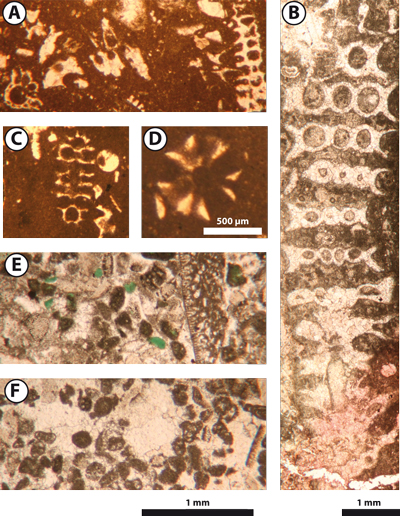
Click on the image to enlarge it.
Plate 3: fig. A. Photomicrograph 01-27: Association of Fourcadella cruciformis ( et ) (to the right) and Actinoporella sp. (to the right).- Zakum regional Stage, field 'X' (offshore Abu Dhabi); fig. B. Photomicrograph 01-01: Oblique section of the large Clypeina ummshaifensis (15 successive whorls).- lowermost Shu'aiba regional Stage, field 'A' (offshore Abu Dhabi); fig. C. Photomicrograph 01-06: Oblique section of Fourcadella cruciformis.- Zakum regional Stage, field 'T' (offshore Abu Dhabi); fig. D. Photomicrograph 01-07 (scale bar = 500 µm): Transverse section of Fourcadella cruciformis.- Zakum regional Stage, field 'T' (offshore Abu Dhabi); fig. E. Photomicrograph 01-16: Glauconite grains.- upper Hawar regional Stage, field 'A' (offshore Abu Dhabi); fig. F. Photomicrograph 01-17: Keystone structures.- lowermost Hawar regional Stage, field 'A' (offshore Abu Dhabi).

Click on the image to enlarge it.
Plate 4: fig. A. Photomicrograph 01-15: Epistomina sp..- Shu'aiba regional Stage, field 'A' (offshore Abu Dhabi); fig. B. Photomicrograph 01-14: Wondersella athersuchi et .- Bab regional Stage, field 'A' (offshore Abu Dhabi); fig. C. Photomicrograph 01-12: Orbitolina (Mesorbitolina) lotzei .- Sabsab regional Substage, field 'B' (offshore Abu Dhabi); fig. D. Photomicrograph 01-13: Orbitolina (Mesorbitolina) parva .- Sabsab regional Substage, field 'B' (offshore Abu Dhabi); fig. E. Photomicrograph 01-08: Orbitolina (Mesorbitolina) parva .- lower Nahr Umr regional Stage (? Sabsab regional Substage), Wadi Bani Kharus (Oman); fig. F. Photomicrograph 01-09: Orbitolina (Mesorbitolina) parva .- lower Nahr Umr regional Stage (? Sabsab regional Substage), Wadi Bani Kharus (Oman); fig. G. Photomicrograph 01-10: Orbitolina (Mesorbitolina) sp..- lower Nahr Umr regional Stage (? Sabsab regional Substage), Wadi Bani Kharus (Oman); fig. H. Photomicrograph 01-11: Orbitolina (Mesorbitolina) parva .- lower Nahr Umr regional Stage (? Sabsab regional Substage), Wadi Bani Kharus (Oman).